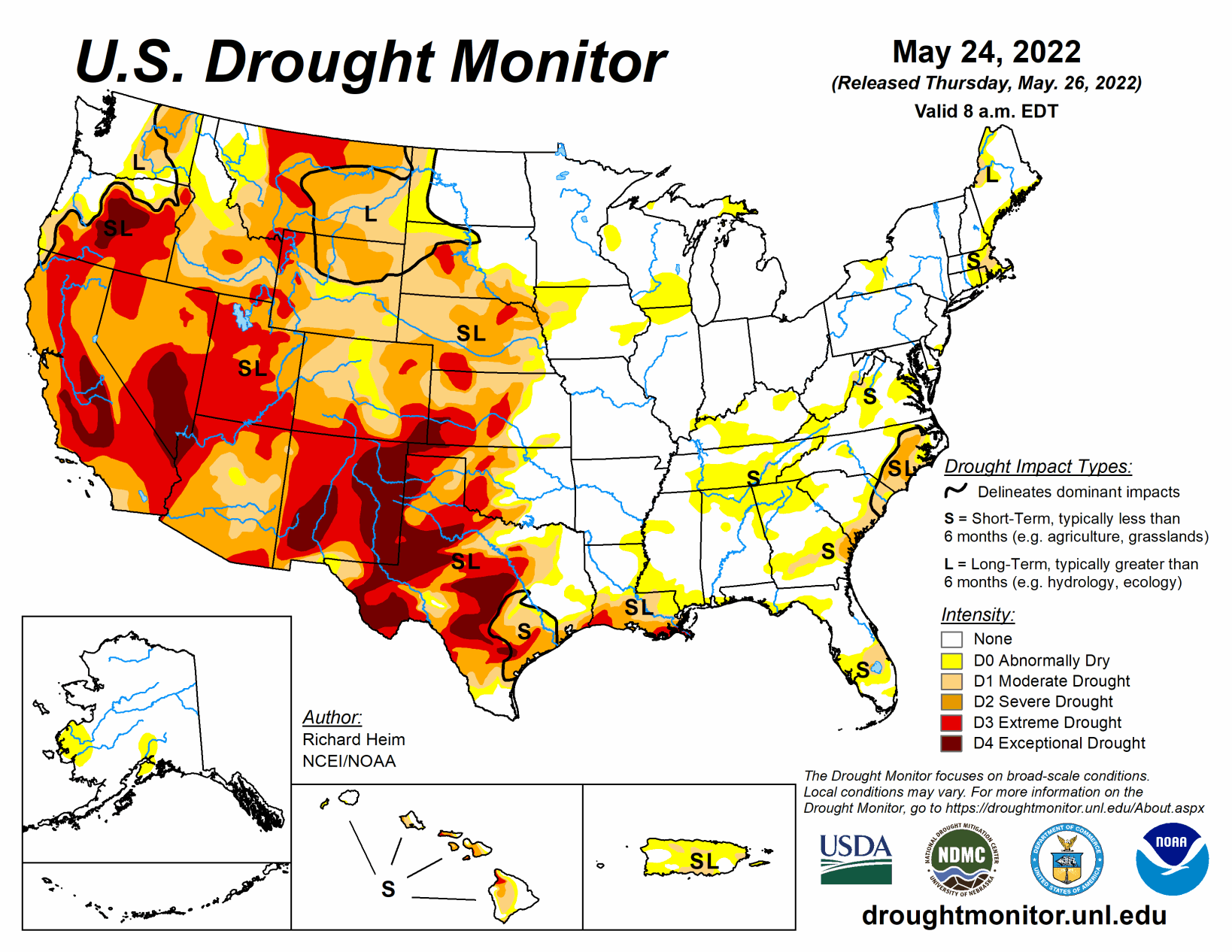A strong upper-level trough moved across the contiguous U.S. during this U.S. Drought Monitor week (May 18 to 24). Surface low pressure systems and cold fronts were associated with this complex trough. They tapped Gulf of Mexico moisture to spread above-normal precipitation across parts of the Plains, Midwest, Southeast, and Mid-Atlantic Coast, and locally heavy snow across parts of Colorado. One of the fronts moved very slowly across the southern Plains near the end of the week, dumping locally heavy rain on parts of Oklahoma and Texas. Precipitation also fell across parts of the Pacific Northwest, North Dakota, and western Great Lakes.
Most of the West was drier than normal, with much of the area from Oregon to California and southern Idaho to New Mexico receiving little to no precipitation. Weekly temperatures averaged below normal behind the fronts from the Pacific Northwest to Great Lakes and from the northern Rockies to Mid-Mississippi Valley. Temperatures averaged warmer than normal across the eastern third of the CONUS and from California to Texas.
The continued lack of precipitation in the dry areas further dried soils, lowered stream levels, and stressed crops and other vegetation, while the warmer-than-normal temperatures increased evapotranspiration that added to the stress caused by lack of precipitation. But widespread heavy rain fell across several drought areas, contracting drought and abnormal dryness, especially in the central to southern Plains, Lower Mississippi Valley, Southeast, and Mid-Atlantic states. Drought and abnormal dryness also shrank in the Pacific Northwest where drought indicators showed improving conditions. Drought or abnormal dryness expanded or intensified where it continued dry, especially in southern parts of the West, in the Ohio and Tennessee Valleys, and parts of southern New England.
South
A large part of Oklahoma and parts of Texas and Louisiana were inundated with several inches of rain, over 6 inches in places. Zapata County in southern Texas received about half a year of normal rainfall this week. Heavy rain in central and northern Oklahoma, and in the Texas Panhandle, southern Texas, and southeast Texas, resulted in the contraction of abnormal dryness and moderate to exceptional drought. Abnormal dryness contracted in Arkansas, D0 and D1 contracted in Mississippi, and D0-D3 shrank in Louisiana. Other parts of the South region were dry. D2-D4 expanded in parts of central to northeast Texas, D0 expanded in Mississippi and Tennessee, and a spot of moderate drought was added in eastern Tennessee.
Midwest
Two inches or more of precipitation fell across southern portions of the Midwest in a band from Missouri to Ohio and across southeastern Minnesota into Wisconsin, while parts of Iowa and Minnesota received less than half an inch of rain. Abnormal dryness expanded in Kentucky and into southern Illinois where this week was drier than normal and precipitation deficits have been building over the last couple months.
High Plains
Two inches or more of precipitation fell across southern and eastern parts of Kansas, central Colorado, and northeast Nebraska, while half an inch or more was widespread across North Dakota. Parts of Nebraska, northeast Colorado, Wyoming, South Dakota, and eastern Montana received less than half an inch of precipitation. In Colorado, moderate to extreme drought contracted where it was wet, while severe and extreme drought expanded where it was dry. Abnormal dryness and moderate to extreme drought shrank in parts of Kansas. The rain ate a hole into severe drought in northeast Nebraska. Abnormal dryness and moderate drought were trimmed in western North Dakota. On the other hand, it was a dry week in western Wyoming with D3 expanding in Teton County.
West
Half of an inch or more of precipitation fell in the Coastal and Cascade ranges of the Pacific Northwest, and northern to central Rockies. But more southerly parts of the West, from southern Oregon to New Mexico, received no precipitation. Abnormal dryness to severe drought were trimmed in Washington, Oregon, Idaho, and Montana.



